
Author: Willd.
Bibliography: Mag. Neuesten Entdeck. Gesammten Naturk. Ges. Naturf. Freunde Berlin 3: 298 (1809)
Year: 1809
Status: accepted
Rank: species
Genus: Juncus
Vegetable: False
Observations: Europe, N. & C. America to S. South America
Baltic rush, known scientifically as Juncus balticus, is a perennial herbaceous plant within the Juncaceae family. First documented in 1809 by the botanist Willdenow in the publication “Mag. Neuesten Entdeck. Gesammten Naturk. Ges. Naturf. Freunde Berlin 3: 298,” this species has garnered interest for its widespread presence and ecological versatility.
This rush is native to a broad geographical range, thriving in diverse climates from Europe to North and Central America and extending as far as southern reaches of South America. Adaptability is one of its key characteristics, and it flourishes in wetland habitats, often found in marshes, along stream banks, and in moist meadows.
Juncus balticus plays a pivotal role in its ecosystem by providing habitat and food for wildlife, stabilizing soil, and contributing to the overall health of wetland environments. The plant typically exhibits slender, erect stems that can grow up to a meter high, and its flowering season adds delicate, small inflorescences that can be striking against the rush’s deep green foliage.
The Baltic rush is esteemed for more than its environmental contributions; it has also gained attention for its potential uses in land restoration projects because of its robust root system, which helps prevent erosion. Its aesthetic appeal makes it a fitting choice for naturalized gardens and landscaping in appropriate climates.
In conclusion, Juncus balticus is much more than a common wetland plant; it is a vital component of diverse ecosystems ranging from the temperate regions of Europe and North America to the more temperate and even subtropical areas of South America. Its presence across this extensive range underscores its adaptability and ecological importance.
Eng: baltic rush, wire rush, wiregrass
Lav: baltijas donis
Deu: baltische binse
Dan: klit-siv
Swe: merivihvilä, östersjötåg
Fin: merivihvilä
Nld: noordse rus
Nno: sandsiv
Nob: sandsiv
Fra: jonc de la baltique
Sme: mearrajiekta
Cym: brwyn y baltig, brwynen y baltig
En: Baltic rush, Wire rush, Arctic rush, Wiregrass
Ar: أسل بلطيقي
Da: Klit-siv
Nl: Noordse rus
Et: Randluga
Fi: Merivihvilä
Fr: Jonc de la Baltique
De: Baltische Binse, Ostsee-Binse
Is: Fitjanál
Lv: Baltijas donis
Nv: Teeł náyizí
Se: Mearrajiekta
Nb: Sandsiv
Nn: Sandsiv
Pl: Sit bałtycki
Sv: Östersjötåg, Merivihvilä
Cy: Brwynen y baltig, Brwyn y Baltig
Taken Mar 1, 2020 by Diego Alex (cc-by-sa)
Taken Jun 6, 2020 by Diego Alex (cc-by-sa)
Taken Jan 1, 2021 by Diego Alex (cc-by-sa)
Taken Oct 10, 2022 by Monica Sosa (cc-by-sa)
Taken Jun 6, 2020 by Diego Alex (cc-by-sa)
Taken Jun 30, 2020 by Diego Alex (cc-by-sa)
© copyright of the Board of Trustees of the Royal Botanic Gardens, Kew.
© copyright of the Board of Trustees of the Royal Botanic Gardens, Kew.
© copyright of the Board of Trustees of the Royal Botanic Gardens, Kew.
Growth form: Rhizomatous
Growth habit: Graminoid
Growth rate: Rapid
Ph maximum: 9.0
Ph minimum: 6.0
Light: 8
Atmospheric humidity: 8
Soil nutriments: 2
Family: Myrtaceae Author: (F.Muell.) K.D.Hill & L.A.S.Johnson Bibliography: Telopea 6: 402 (1995) Year: 1995 Status:…
Family: Rubiaceae Author: Pierre ex A.Froehner Bibliography: Notizbl. Bot. Gart. Berlin-Dahlem 1: 237 (1897) Year:…
Family: Sapindaceae Author: Koidz. Bibliography: J. Coll. Sci. Imp. Univ. Tokyo 32(1): 38 (1911) Year:…
Family: Asteraceae Author: A.Gray Bibliography: Pacif. Railr. Rep.: 107 (1857) Year: 1857 Status: accepted Rank:…
Family: Fabaceae Author: Medik. Bibliography: Vorles. Churpfälz. Phys.-Ökon. Ges. 2: 398 (1787) Year: 1787 Status:…
Family: Aspleniaceae Author: (Cav.) Alston Bibliography: Bull. Misc. Inform. Kew 1932: 309 (1932) Year: 1932…